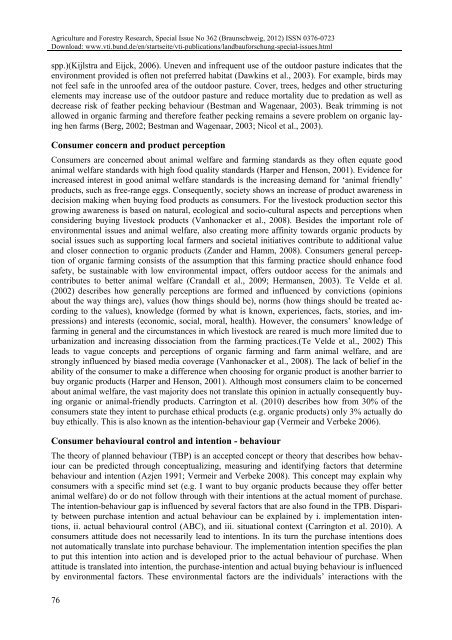Tackling the future challenges of Organic Animal Husbandry - vTI
Tackling the future challenges of Organic Animal Husbandry - vTI
Tackling the future challenges of Organic Animal Husbandry - vTI
You also want an ePaper? Increase the reach of your titles
YUMPU automatically turns print PDFs into web optimized ePapers that Google loves.
! Agriculture and Forestry Research, Special Issue No 362 (Braunschweig, 2012) ISSN 0376-0723<br />
Download: www.vti.bund.de/en/startseite/vti-publications/landbauforschung-special-issues.html<br />
spp.)(Kijlstra and Eijck, 2006). Uneven and infrequent use <strong>of</strong> <strong>the</strong> outdoor pasture indicates that <strong>the</strong><br />
environment provided is <strong>of</strong>ten not preferred habitat (Dawkins et al., 2003). For example, birds may<br />
not feel safe in <strong>the</strong> unro<strong>of</strong>ed area <strong>of</strong> <strong>the</strong> outdoor pasture. Cover, trees, hedges and o<strong>the</strong>r structuring<br />
elements may increase use <strong>of</strong> <strong>the</strong> outdoor pasture and reduce mortality due to predation as well as<br />
decrease risk <strong>of</strong> fea<strong>the</strong>r pecking behaviour (Bestman and Wagenaar, 2003). Beak trimming is not<br />
allowed in organic farming and <strong>the</strong>refore fea<strong>the</strong>r pecking remains a severe problem on organic laying<br />
hen farms (Berg, 2002; Bestman and Wagenaar, 2003; Nicol et al., 2003).<br />
Consumer concern and product perception<br />
Consumers are concerned about animal welfare and farming standards as <strong>the</strong>y <strong>of</strong>ten equate good<br />
animal welfare standards with high food quality standards (Harper and Henson, 2001). Evidence for<br />
increased interest in good animal welfare standards is <strong>the</strong> increasing demand for ‘animal friendly’<br />
products, such as free-range eggs. Consequently, society shows an increase <strong>of</strong> product awareness in<br />
decision making when buying food products as consumers. For <strong>the</strong> livestock production sector this<br />
growing awareness is based on natural, ecological and socio-cultural aspects and perceptions when<br />
considering buying livestock products (Vanhonacker et al., 2008). Besides <strong>the</strong> important role <strong>of</strong><br />
environmental issues and animal welfare, also creating more affinity towards organic products by<br />
social issues such as supporting local farmers and societal initiatives contribute to additional value<br />
and closer connection to organic products (Zander and Hamm, 2008). Consumers general perception<br />
<strong>of</strong> organic farming consists <strong>of</strong> <strong>the</strong> assumption that this farming practice should enhance food<br />
safety, be sustainable with low environmental impact, <strong>of</strong>fers outdoor access for <strong>the</strong> animals and<br />
contributes to better animal welfare (Crandall et al., 2009; Hermansen, 2003). Te Velde et al.<br />
(2002) describes how generally perceptions are formed and influenced by convictions (opinions<br />
about <strong>the</strong> way things are), values (how things should be), norms (how things should be treated according<br />
to <strong>the</strong> values), knowledge (formed by what is known, experiences, facts, stories, and impressions)<br />
and interests (economic, social, moral, health). However, <strong>the</strong> consumers’ knowledge <strong>of</strong><br />
farming in general and <strong>the</strong> circumstances in which livestock are reared is much more limited due to<br />
urbanization and increasing dissociation from <strong>the</strong> farming practices.(Te Velde et al., 2002) This<br />
leads to vague concepts and perceptions <strong>of</strong> organic farming and farm animal welfare, and are<br />
strongly influenced by biased media coverage (Vanhonacker et al., 2008). The lack <strong>of</strong> belief in <strong>the</strong><br />
ability <strong>of</strong> <strong>the</strong> consumer to make a difference when choosing for organic product is ano<strong>the</strong>r barrier to<br />
buy organic products (Harper and Henson, 2001). Although most consumers claim to be concerned<br />
about animal welfare, <strong>the</strong> vast majority does not translate this opinion in actually consequently buying<br />
organic or animal-friendly products. Carrington et al. (2010) describes how from 30% <strong>of</strong> <strong>the</strong><br />
consumers state <strong>the</strong>y intent to purchase ethical products (e.g. organic products) only 3% actually do<br />
buy ethically. This is also known as <strong>the</strong> intention-behaviour gap (Vermeir and Verbeke 2006).<br />
Consumer behavioural control and intention - behaviour<br />
The <strong>the</strong>ory <strong>of</strong> planned behaviour (TBP) is an accepted concept or <strong>the</strong>ory that describes how behaviour<br />
can be predicted through conceptualizing, measuring and identifying factors that determine<br />
behaviour and intention (Azjen 1991; Vermeir and Verbeke 2008). This concept may explain why<br />
consumers with a specific mind set (e.g. I want to buy organic products because <strong>the</strong>y <strong>of</strong>fer better<br />
animal welfare) do or do not follow through with <strong>the</strong>ir intentions at <strong>the</strong> actual moment <strong>of</strong> purchase.<br />
The intention-behaviour gap is influenced by several factors that are also found in <strong>the</strong> TPB. Disparity<br />
between purchase intention and actual behaviour can be explained by i. implementation intentions,<br />
ii. actual behavioural control (ABC), and iii. situational context (Carrington et al. 2010). A<br />
consumers attitude does not necessarily lead to intentions. In its turn <strong>the</strong> purchase intentions does<br />
not automatically translate into purchase behaviour. The implementation intention specifies <strong>the</strong> plan<br />
to put this intention into action and is developed prior to <strong>the</strong> actual behaviour <strong>of</strong> purchase. When<br />
attitude is translated into intention, <strong>the</strong> purchase-intention and actual buying behaviour is influenced<br />
by environmental factors. These environmental factors are <strong>the</strong> individuals’ interactions with <strong>the</strong><br />
76

















